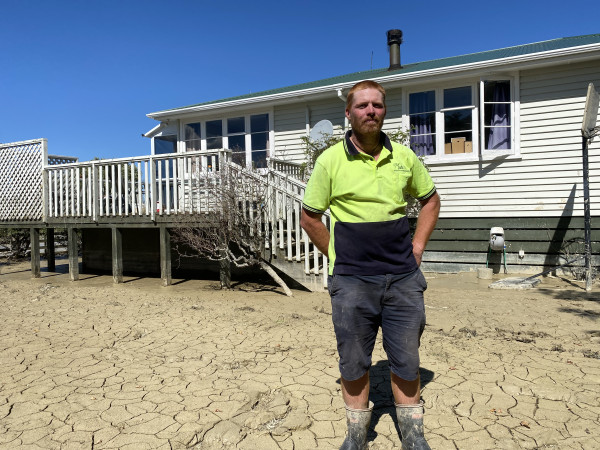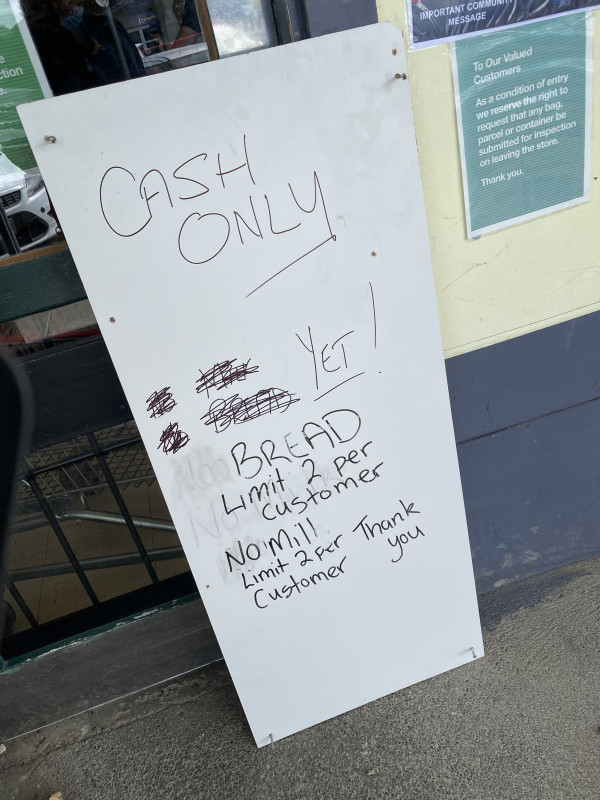"Every day feels like a year" - Cyclone Gabrielle
1 March 2023
While some growers lost their land, their crops and their homes, others remained untouched. As KRISTINE WALSH discovers, Cyclone Gabrielle was selective in the damage it did as it swept across the Gisborne-Tairāwhiti region.

Grower, Matt Sowerby, outside his flood-struck home near Manutūkē
Just ten kilometres south of Gisborne city is the bridge that spans the famous Te Arai River, generally regarded as liquid gold for the Manutūkē growers that operate along its banks.
That was until the early hours of Tuesday 14 February – Valentine's Day – when it became a poisoned chalice, swelling to a raging torrent, tossing trees like Pick-Up Sticks and cloaking orchards in a sea of silt.
At the start of the riverside Waingake Road at Manūtukē, plantings of avocado trees sit knee-deep in suffocating silt. A citrus orchard a little further up the line suffered the same fate, while the small township escaped unscathed.
Further still, the river swept across an annual growing operation, inundating the sheds and a car left by the fleeing owner, but somehow, leaving the house untouched.
Back on the main road, Matt Sowerby could hardly believe his luck when he got up early Tuesday morning and saw just a few puddles in his front yard.
As nursery and harvest manager for major local grower Judco, he headed out to inspect damage at blocks he oversees all over the district.
But when driving back past just after 9am, he could see water rising in the back paddock. With the river still raging, there was nowhere else for the stream bordering Matt's property to go.
A father of five, including eight-month-old twins, he knew he had to move fast to get his wife and children out, while police busted down the front fence to release distressed cattle.
He was the last to leave, kayaking across the front yard to rescue the beloved family dog.
And the same was happening next door at Judco's nursery and office headquarters.
“The problem was that, the river being what it was, the water couldn't drain so it just sat there for more than 36 hours,” Matt says.
“When it finally did drain, we ended up with a metre-and-a-half of silt up to and into the house, which we'd just finished renovating.
“The house was jacked up high after Cyclone Bola to stop this happening, but in this huge event, it just wasn't enough.”
While there are growers up the East Coast north of Gisborne, the area is dominated by forestry and sheep and beef farming and was already reeling from multiple events before Cyclone Gabrielle, most recently January's ex-tropical Cyclone Hale.
To say the area was devastated by Gabrielle would be an understatement. But after previous events an enraged community had already mobilised in getting high-level support to confront the forestry debris that had been tearing down their hills, smashing up their homes, roads and bridges.
Inland from Gisborne city, both north (towards the Bay of Plenty) and south (towards Wairoa), is home to the largest concentration of the region's horticulture, and even there effects vary from no impact to total catastrophe.
And halfway between Gisborne and Mātāwai, where the entire community of Te Karaka was evacuated, there was heartbreaking loss of life.
Up to 10 days after Gabrielle began its assault on 13 February the Gisborne-Tairāwhiti region was still in a state of “extreme” alert water shortage, with pipelines to the main supply (the Mangapoike Dams) smashed and major faults at the back-up Waipaoa Water Treatment Plant.
And even as it moved towards the lesser “high” alert it was unlikely major processors would be allowed to tap into mains water supplies.
That had a big impact on operators like LeaderBrand which, according to chief executive Richard Burke, was doing well in the face of a range of challenges.
“This first week every day feels like a year, but we've managed to stand up to a whole lot of stuff,” he said.
“Having power and being able to get comms on was helpful, but having no water is a big issue that's going to impact on the processing side of the operation.”
Richard says the Waipaoa Flood Control Scheme – whereby stopbanks are being raised along the river banks – had helped protect a large portion of the Poverty Bay Flats, where LeaderBrand's Gisborne growing operation is centred.
“So by day four (17 February) we were able to start harvesting things like fresh lettuce and sweetcorn on blocks that weren't flooded, and by Sunday we were harvesting some of the sauvignon blanc in our vineyards.
“Basically, it's a moving target so we're just piecing things together as we go, focusing in the short term on what has been wiped out, what can be salvaged, and where to go from here.”
LeaderBrand had built resilience in its business by establishing farms in other regions, Richard added.
“But we've certainly got a lot to work through, so we're going at it day by day.”
Up the road at Kaiaponi Farms, general manager Scott Wilson was juggling the company's own orchards, those it manages for other growers, its major packing facility, and the challenges of shipping produce from an area cut off in both directions.
He, too, believed the stopbanks had done their job and protected many growing operations, “so we mostly had to deal with what fell on top of us”.
For Kaiaponi's orchards, that was recorded at around 220ml of rain, with most getting through with low levels of loss.

The first week after Cyclone Gabrielle was a rough one for Gisborne residents, with no power, no internet, no eftpos, no bread and no milk
“But we do have growers at the other extreme, mostly in pockets like Waingake and Manutūkē.
“And of course, many of our staff have issues as well. Many were flooded, some not too much, others right up to having their homes red-stickered.”
But those who could be on board were on board, and Scott says his team returned to harvesting apples from selected blocks just two days after the storm.
“Being in the middle of the Gala harvest we couldn't risk those fruit getting over-mature, so we were able to get through and complete most of that and get the packhouse up and running by day seven.
“But with that have come some major logistical challenges, including around getting fruit to market.”
Kaiaponi traditionally freights its apples through Napier Port, but with access cut off is instead sending trucks north to Tauranga.
“There will be ongoing challenges with getting packaging supplies in and getting fruit out, and that's going to have an inevitable impact on costs,” Scott said.
Overall, there have been bad things: especially in evacuated rural areas, looters came out to play (one pair reportedly earning a “good hiding” from an alert property owner).
And there have been good things: entire teams of gumboot-clad volunteers turning up to help complete strangers dig out tonnes, and tonnes, and tonnes of silt.
But the general feeling is one of gratitude, especially in the light of devastation wreaked on the neighbouring Hawke's Bay region.
Those flooded with water are grateful it’s not mud. Those with mud are grateful their houses were spared. Those who lost their homes are grateful loved ones escaped with their lives.
As Scott Wilson said, “even with what we have to deal with here, we look over at places like Hawke's Bay and it makes us feel fortunate.”
“Our thoughts are with those severely affected growers, those severely affected people, and what they have to deal with now and into the future.”
Meanwhile, a week after Gabrielle blew through town, Matt Sowerby continued with what work he could, even though his own property was munted and he'd crammed his whānau of seven in with an equal number of family members up the road.
“Like many around here, we (Judco) have been both lucky and unlucky,” he says.
“On the one hand, we've lost crops, including maize, tomatoes and a paddock of echinacea we were growing for seed export.
“On the other, though the nursery houses were a metre deep in water, they'd been cleared out for new seedlings – which we've been able to get in – so like everybody else we're moving forward as best we can.”
First published in the March 2023 issue of The Orchardist and NZGrower magazines.
